Ameda Temple of Naga Raja
The Ameda Temple of Naga Raja is located in Udayamperoor, Ernakulam district, Kerala, India. The temple is dedicated to Nagaraja, the serpent god, and his consort Nagayakshi. The temple is also home to the Saptha Matrikas, or seven mother goddesses.
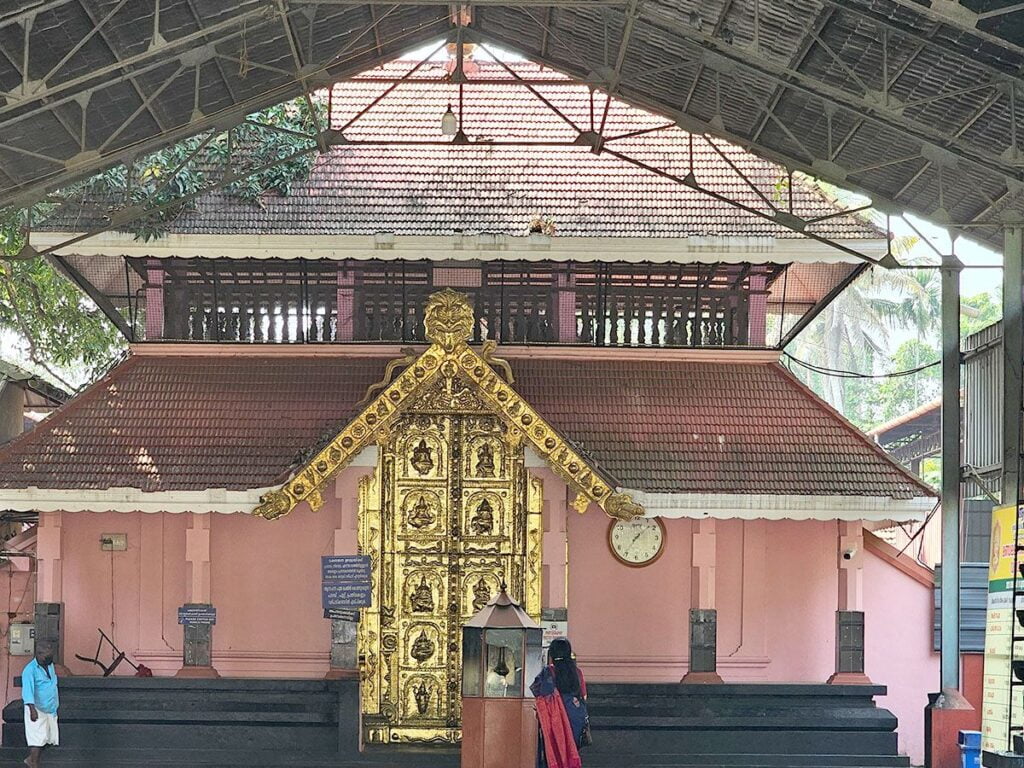
Contents
Ameda Temple History:
Origin Story:
The most popular legend attributes the temple’s establishment to the mythical sage Parasurama. As the story goes, while performing rituals on the banks of the Vembanad Lake, Parasurama witnessed a bright light emanating from the water’s center. Intrigued, he walked towards it, unknowingly disturbing a meditating tortoise (“Aama” in Malayalam). Feeling remorseful for interrupting the tortoise, Parasurama decided to build a temple dedicated to the divine mothers (“Sapthamathrukkal”) at that very spot. The place where the tortoise stopped (“Aamaninnayidam”) eventually evolved into the name “Ameda.”
Historical Context:
While the origin story adds a mythical charm, pinpointing the temple’s actual age proves challenging. Some experts believe the original structure might have been much simpler, possibly dating back several centuries. Over time, it likely underwent renovations and additions, shaping the temple we see today.
Read More>> 3rd CE Vadakkunnathan Temple Built by Parashurama
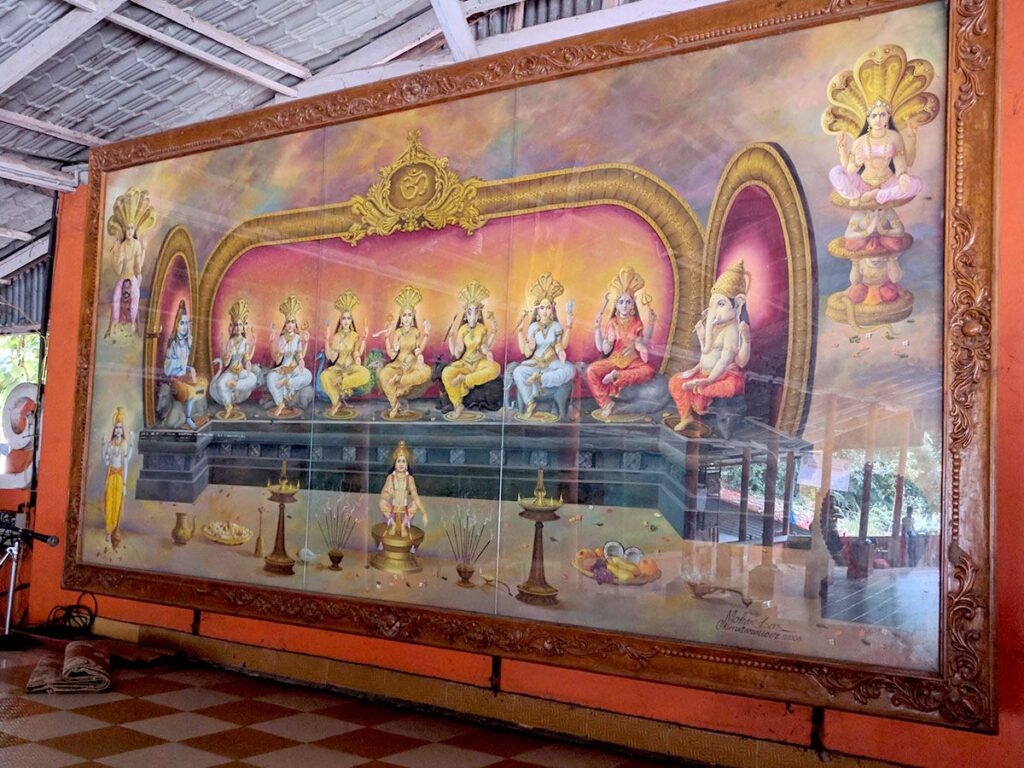
Legend of Ameda Temple:
Version 1: Sage Parasurama and the Serpents
- Lord Parasurama, an incarnation of Lord Vishnu, is credited with creating Kerala by throwing his axe into the sea and letting the land emerge. However, the land remained infertile due to salinity.
- Seeking a solution, Parasurama prayed to Lord Shiva, who guided him to seek help from Nagaraja, the king of serpents.
- Parasurama performed intense penance to please Nagaraja. Pleased by his devotion, Nagaraja agreed to help. His serpents desalinated the land by spitting their venom, making it fertile.
- As a token of gratitude, Parasurama offered the serpents a piece of land for undisturbed habitation. He also consecrated a temple dedicated to Nagaraja, believed to be the Ameda Temple.
Version 2: The Divine Tortoise and the Sapthamathrukkal
- The legend revolves around the Sapthamathrukkal, seven mother goddesses, including Brahmani, Maheshwari, Kowmari, Vaishnavi, Varahi, Indrani, and Chamundi.
- These goddesses were traveling on a tortoise through the Vembanad Lake. When Lord Parasurama stepped into the lake for his prayers, the tortoise stopped, unable to move forward.
- It turns out, Parasurama’s presence had unknowingly parted the water, hindering the tortoise. He realized his unintentional interference and decided to build a temple on the very spot.
- Since “aama” means tortoise in Malayalam, the place came to be known as Aamaninnayidam, later evolving into Ameda. The temple housed not just the Sapthamathrukkal but also deities like Veerabhadran and Ganapathy.
Read More>> Thiruvairanikulam Mahadeva Temple
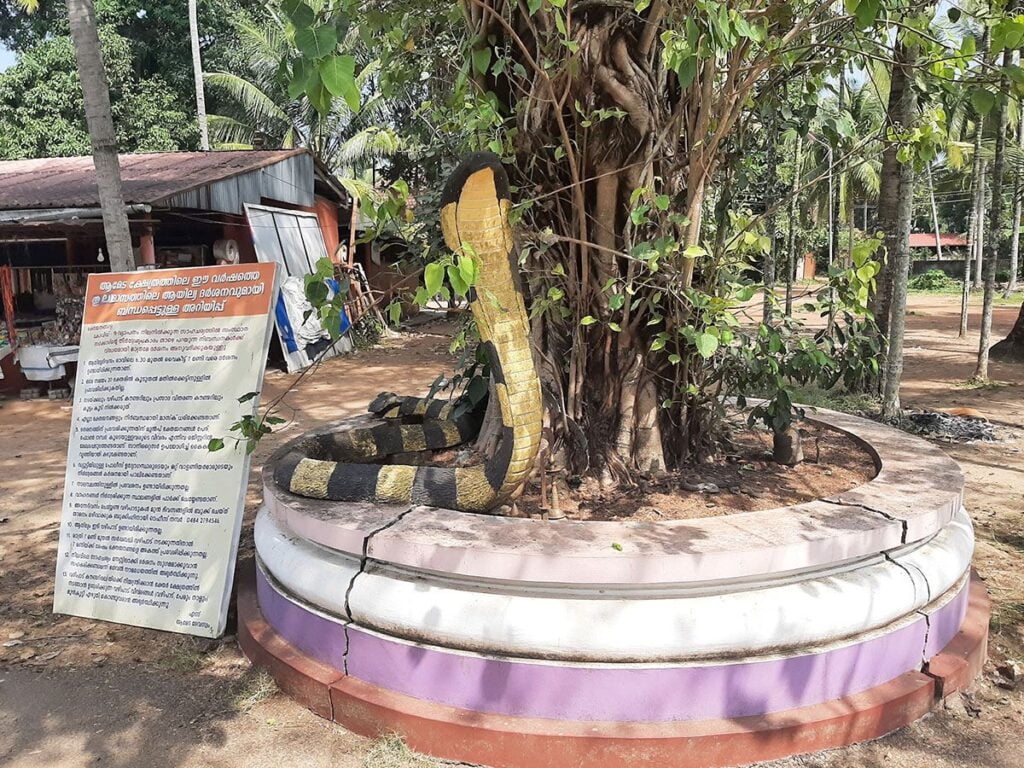
Significance of Ameda Temple:
Religious Significance:
- Unique Deities: It is one of the few temples dedicated to Nagaraja (King of Serpents) and Nagayakshi (Queen of Serpents) in Kerala. These deities are associated with fertility, prosperity, protection from snake bites, and healing.
- Saptha Mathrukkal: The temple is also known for enshrining the Saptha Mathrukkal, seven mother goddesses representing various aspects of Devi. This makes the temple unique and attracts devotees seeking blessings for family well-being.
- Other Deities: The temple complex houses shrines dedicated to other deities like Lord Shiva, Lord Ganesha, and Lord Vishnu, catering to a wider range of devotees.
Historical Significance:
- Legend: The temple’s history is linked to the legendary sage Parasurama, who is believed to have consecrated it. This adds to the temple’s spiritual and cultural significance.
- Architectural Style: Though details are limited, the temple’s architecture is likely to reflect the traditional Kerala temple style, with intricate carvings and sculptures holding historical value.
Cultural Significance:
- Festivals: The temple’s annual festival, held in the Meenam month (March-April), attracts large crowds and is a major cultural event in the region.
- Local Beliefs: The temple is deeply rooted in local beliefs and traditions related to serpent worship and the Saptha Mathrukkal. This adds to its cultural significance for the local community.
Read More>> Treta Yuga Vaikom Mahadeva Temple
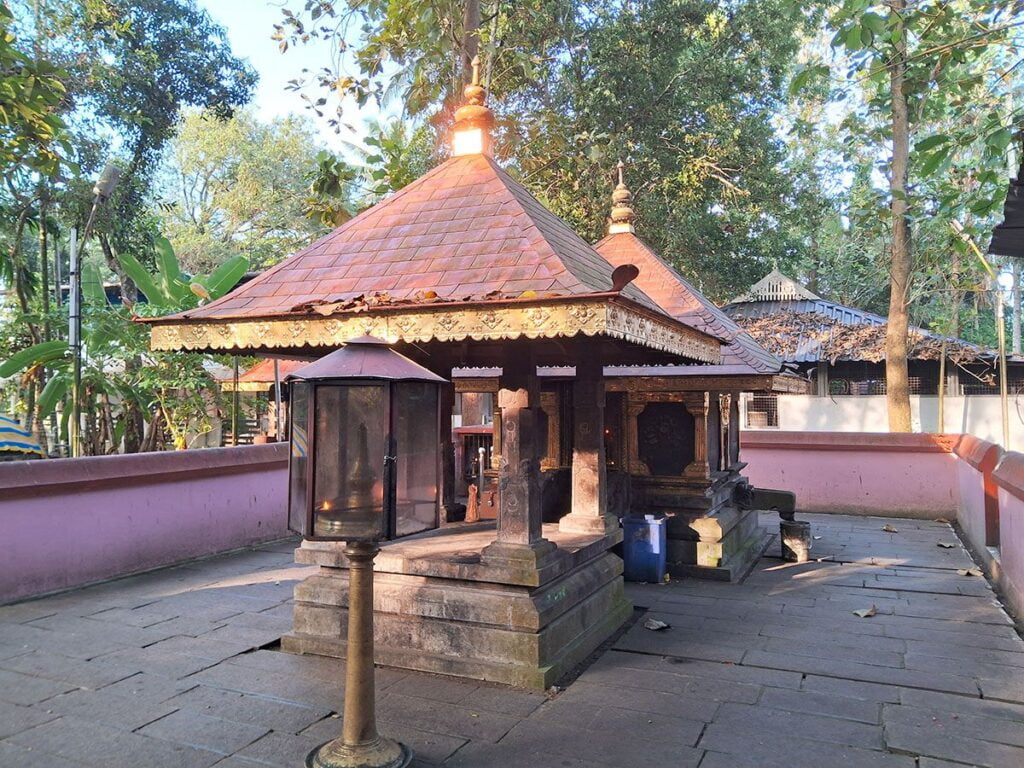
Myths of Ameda Temple:
1. Myth of Parasurama and Naga Raja:
- The most popular myth connects the temple’s consecration to the legendary sage Parasurama. As the story goes, while traveling along the coast, Parasurama noticed a bright light emanating from the center of the Vembanad Lake. Intrigued, he waded into the water, unknowingly causing a tortoise (Aama in Malayalam) to stop its journey.
- Feeling guilty, Parasurama decided to build a temple dedicated to the Sapthamathrukkal deities (seven mother goddesses) at the place where the tortoise stopped. This location became known as “Aamaninnayidam,” eventually transforming into “Ameda.”
- To further appease the serpent spirits, Parasurama sought the help of Nagaraja, the king of serpents. Pleased by Parasurama’s devotion, Nagaraja blessed the land and agreed to reside there, making the temple a sacred abode for serpent deities.
2. Myth of the Hidden Treasure:
- There’s a persistent belief that a vast treasure trove lies hidden somewhere within the temple premises. This myth originates from an old map supposedly found near the temple, containing cryptic clues about the treasure’s location. However, despite numerous searches, the treasure remains undiscovered, adding to the temple’s mystique.
3. Myth of the Snake Charmer’s Curse:
- A lesser-known myth tells the story of a snake charmer who, angered by the temple’s restrictions on his performances, cursed the place. According to the myth, the curse caused harm to anyone who dared to enter the temple with ill intentions. While there’s no historical evidence to support this claim, it adds another layer of intrigue to the temple’s lore.
4. Myth of the Wish-Fulfilling Serpent God:
- Devotees believe that offering prayers and seeking blessings from the Naga Raja deity can bring good fortune and fulfill wishes. This belief stems from the general association of serpents with fertility, prosperity, and protection in Hindu mythology.
Read More>> Sabarimala Temple: Abode of Lord Ayyappa
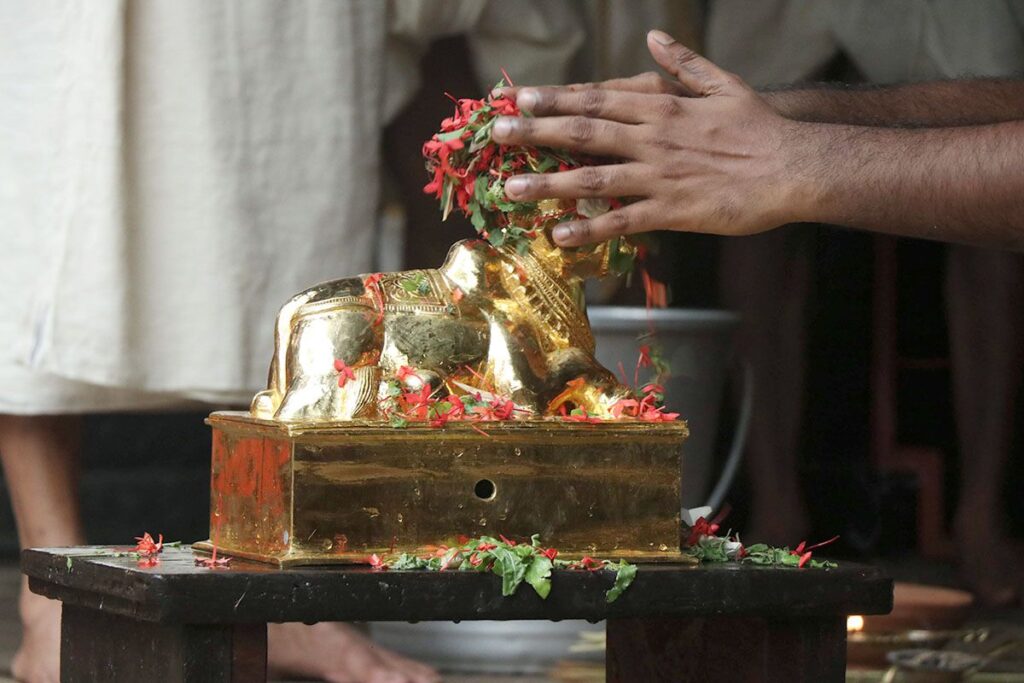
Ameda Temple Timing and Rituals:
Timings:
- The temple is open from 5:00 AM to 12:00 PM and from 4:00 PM to 9:00 PM.
Rituals:
- The main ritual performed at the temple is the Naga Dosha Puja. This puja is performed to appease the Naga Devatas (serpent deities) and to ward off any negative effects they may have on one’s life.
- Other pujas performed at the temple include the Sarpa Samskar Puja, the Naga Prathista Puja, and the Naga Homam. These pujas are performed for specific purposes, such as to bless children, to improve one’s health, or to achieve success in business.
Read More>> Baidyanath Temple – Sacred Jyotirlinga with Location Dispute
Places to visit near Ameda Temple:
- Fort Kochi: Known for its colonial architecture, vibrant art scene, and the famous Chinese fishing nets, Fort Kochi is a must-visit. Explore the Fort Kochi beach, St. Francis Church, Mattancherry Palace, and the Jewish Synagogue.
- Marine Drive: Enjoy a leisurely stroll along the Marine Drive promenade in Kochi, overlooking the backwaters. The area is well-lit and offers beautiful views of the sunset.
- Hill Palace Museum: Located in Tripunithura, the Hill Palace is Kerala’s first heritage museum. It showcases the royal collections of the erstwhile Maharaja of Kochi and includes artifacts, paintings, and sculptures.
- Bolgatty Palace and Island: Visit Bolgatty Island, accessible by a short boat ride, and explore the Bolgatty Palace. The palace has been converted into a heritage hotel and offers a peaceful retreat.
- Veega Land Amusement Park: If you’re traveling with family and enjoy amusement parks, Veega Land (now Wonderla Kochi) is a popular option for thrilling rides and entertainment.
- Kodanad Elephant Training Centre: Located on the banks of the Periyar River, Kodanad is known for its elephant training center. You can watch elephants being bathed and trained in a natural setting.
- Thattekad Bird Sanctuary: About 50 km from Ernakulam, Thattekad is a haven for bird watchers. The sanctuary is home to a variety of migratory and resident birds.
- Chottanikkara Bhagavathy Temple: Visit this famous temple dedicated to Goddess Bhagavathy, located in Chottanikkara, about 20 km from Ernakulam.
- Wonderla Kochi: If you’re looking for a day of fun and excitement with rides and attractions, Wonderla Kochi is a popular amusement park near Udayamperoor.
FAQ:
What is the Ameda Temple of Naga Raja?
The Ameda Temple of Naga Raja, also known as Ameda Nagaraja Temple, is a Hindu temple located on the banks of Vembanad Lake in Udayamperoor, Ernakulam district, Kerala, India. It is dedicated to Nagaraja, the king of serpents, and Nagayakshi, his consort. The temple is also known for enshrining the Sapta Matrikas, the seven mother goddesses.
What are its unique features?
- One of the few Nagaraja temples in Kerala.
- Houses the Sapta Matrikas, rarely found in other temples.
- Main sanctum sanctorum with three doors, opened only on two specific days each year.
- Picturesque location on the banks of Vembanad Lake.
What is the temple’s history and significance?
Legend connects the temple’s consecration to Parasurama, a mythical figure in Hinduism. The temple is believed to be centuries old and holds significance for devotees seeking blessings for health, prosperity, and protection from snake bites.
What are the temple timings and festivals?
- The temple is open daily from 5:00 AM to 8:00 PM.
- The main festival, dedicated to Nagaraja and Nagayakshi, is held in the Malayalam month of Meenam (March-April).
- Another important festival is Guruthy Pooja, celebrated 41 days after Meenam.
How do I reach the temple?
- The temple is located approximately 20 km south of Ernakulam city.
- You can take a taxi, auto rickshaw, or bus to reach Udayamperoor.
- The nearest railway station is Ernakulam Junction.
- The nearest airport is Cochin International Airport, Nedumbassery.
Are there any other things to know before visiting the temple?
- Dress modestly and respectfully.
- Remove your footwear before entering the temple.
- Photography inside the temple is not allowed.
- Offerings can be made in the designated hundi (donation box).
How to reach Ameda Temple:
- By Air:
- The nearest airport is Cochin International Airport (COK), which is approximately 35-40 kilometers away from Udayamperoor. You can hire a taxi or use other local transportation options from the airport to reach your destination.
- By Train:
- Ernakulam Junction (South) is a major railway station in the vicinity. From there, you can hire a taxi or use local transportation to reach Udayamperoor.
- By Bus:
- Udayamperoor is well-connected by road, and you can take a bus to reach the locality. Ernakulam has a comprehensive bus network, and you can inquire about the specific buses that go to Udayamperoor at the local bus station.
